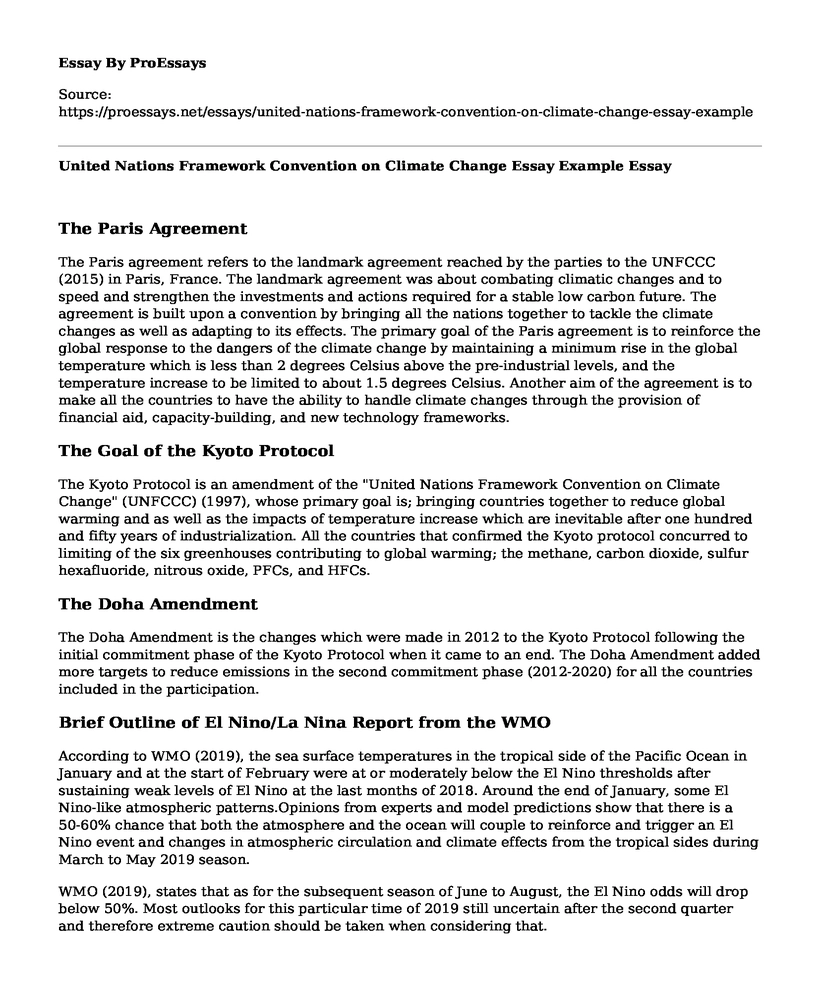The Paris Agreement
The Paris agreement refers to the landmark agreement reached by the parties to the UNFCCC (2015) in Paris, France. The landmark agreement was about combating climatic changes and to speed and strengthen the investments and actions required for a stable low carbon future. The agreement is built upon a convention by bringing all the nations together to tackle the climate changes as well as adapting to its effects. The primary goal of the Paris agreement is to reinforce the global response to the dangers of the climate change by maintaining a minimum rise in the global temperature which is less than 2 degrees Celsius above the pre-industrial levels, and the temperature increase to be limited to about 1.5 degrees Celsius. Another aim of the agreement is to make all the countries to have the ability to handle climate changes through the provision of financial aid, capacity-building, and new technology frameworks.
The Goal of the Kyoto Protocol
The Kyoto Protocol is an amendment of the "United Nations Framework Convention on Climate Change" (UNFCCC) (1997), whose primary goal is; bringing countries together to reduce global warming and as well as the impacts of temperature increase which are inevitable after one hundred and fifty years of industrialization. All the countries that confirmed the Kyoto protocol concurred to limiting of the six greenhouses contributing to global warming; the methane, carbon dioxide, sulfur hexafluoride, nitrous oxide, PFCs, and HFCs.
The Doha Amendment
The Doha Amendment is the changes which were made in 2012 to the Kyoto Protocol following the initial commitment phase of the Kyoto Protocol when it came to an end. The Doha Amendment added more targets to reduce emissions in the second commitment phase (2012-2020) for all the countries included in the participation.
Brief Outline of El Nino/La Nina Report from the WMO
According to WMO (2019), the sea surface temperatures in the tropical side of the Pacific Ocean in January and at the start of February were at or moderately below the El Nino thresholds after sustaining weak levels of El Nino at the last months of 2018. Around the end of January, some El Nino-like atmospheric patterns.Opinions from experts and model predictions show that there is a 50-60% chance that both the atmosphere and the ocean will couple to reinforce and trigger an El Nino event and changes in atmospheric circulation and climate effects from the tropical sides during March to May 2019 season.
WMO (2019), states that as for the subsequent season of June to August, the El Nino odds will drop below 50%. Most outlooks for this particular time of 2019 still uncertain after the second quarter and therefore extreme caution should be taken when considering that.
During the season of March to May, the sea surface temperatures will be around 0.6-0.9 degrees Celsius at the tropical Pacific especially the east-central part and may lead to a strong El Nino event. The development of La Nina is unlikely in the first three quarters in 2019.
Why CFC Emissions are increasing
The increasing emission of Chlorofluorocarbons (CFC) is as a result of the continued use in the refrigerators as leakages, the use of aerosols and air conditioning systems which emit such gases. The CFCs can also be released from industries which produce them, use them and any other product which contains these gases. However; there is no thought of any natural source which emits CFCs to the environment (GHG, 2018).
References
Green House Gas Emission. (2018). United States Environmental Protection Agency.United Nations Framework Convention on Climate Change. (2012, December 21). The Doha Amendment, United Nations Climate Change.Retrieved on 18th March 2019 from https://unfccc.int/process
United Nations Framework Convention on Climate Change. (2015, December 12).The Paris Agreement, United Nations Climate Change. Retrieved on 18th March 2019 from https://unfccc.int/process
United Nations Framework Convention on Climate Change. United Nations Climate Change. (1997, December 11). The Kyoto Protocol, United Nations Climate Change. Retrieved on 18th March 2019 from https://unfccc.int/process
World Metrological Organization. (2019, February 26 ). Current Situation Outlook, El Nino/La Nina Update.
Cite this page
United Nations Framework Convention on Climate Change Essay Example. (2022, Dec 06). Retrieved from https://proessays.net/essays/united-nations-framework-convention-on-climate-change-essay-example
If you are the original author of this essay and no longer wish to have it published on the ProEssays website, please click below to request its removal:
- Mechanism of Groundwater Inrush Hazard Caused by Solution Mining in a Multilayered Rock-Salt-Mining Area
- Articles Review on Climate Change Paper Example
- Essay Example on Global Warming and Ozone Depletion: Impact and Causes
- Park Rangers: Protecting Nature & Preserving Safety - Essay Sample
- Essay Example on Nurses Help Combat Communicable Diseases After Earthquakes
- Essay Example on Accelerating Energy Transitions for Clean, Efficient, and Safe Energy
- Research Paper Sample on Climate Justice: An Ethical and Political Issue







